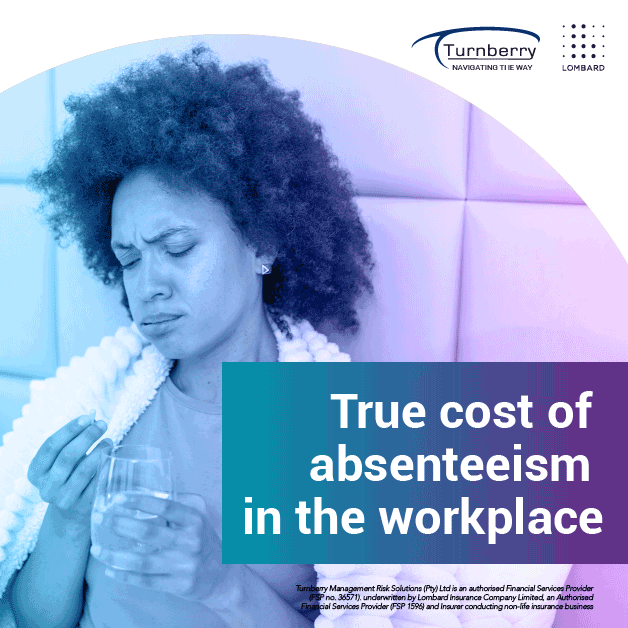
FA News – 3rd August 2022
The success of a business is built on the wellbeing and health of its workforce. Evidence suggests that maintaining employee health results in increased productive yield and business performance. People miss work for a variety of reasons including illness and injuries as well as mental health problems such as burnout, stress and disengagement in the workplace.
Absenteeism is costing South African businesses billions of rands every year, affecting not only the bottom line, but also having a negative impact on employee morale and a company’s overall productivity. Occupational Care South Africa (OCSA) reveals that absenteeism costs the South African economy around R12 billion to R16 billion per year, and the Human Capital Review estimates it to be even higher, at R19.144 billion annually. This equates to about 15% of employees being absent on any given day.
While absenteeism in the workplace must be tackled holistically, there are various mechanisms that organisations could leverage to lower absenteeism rates. The benefit of implementing a comprehensive health and wellbeing package that includes gap cover in their corporate financial planning package should not be underestimated. This is according to Tony Singleton, CEO of Turnberry Management Risk Solutions, who says that without gap cover, employees are often prone to not seeking the medical treatment they need, or delay getting treatment until they can afford to pay for it.
Financial constraints
“Without gap cover, many employees either can’t afford to pay hospital co-payments or charges that are above medical aid rates to receive the treatment they need. This is further exacerbated in a workplace environment where there is a fear of a loss of employment or in jobs where there is no protected time off, meaning that if you miss a day or a shift you don’t get paid,” says Singleton.
However, delaying treatment for an ailment or health condition can often result in more serious health problems, driving up the cost of absenteeism in the long term for the employer. Singleton explains that when left untreated, disease progression could result in a mild ailment eventually developing into a serious illness or even a medical emergency.
“Worsening health changes the situation, resulting in the person staying off work for a longer period of time to recover from a serious condition. This means that the employer often has to pull in other employees to cover that person’s work or in some cases even having to hire temporary staff to handle the additional workload,” he says.
Johannesburg-based psychiatrist Dr Alexandra Maisto says it’s important that employers consider the mental health aspect that may be associated with financial stress and the impact this could have on absenteeism and the organisation. “The additional stress caused by fears of job security and the financial burden of paying for medical treatment can often result in or exacerbate anxiety, depression, and other mental health problems. This can lead to even more absenteeism,” explains Dr Maisto.
Impact on other staff
There may be an additional indirect cost of absenteeism, amongst workers who are under increasing pressure to compensate and fill the gaps of absent employees.
“This can overburden the remaining staff at work; thus, increasing their risk of burnout and disengagement and lead to further absences. It’s a bit of a chicken and egg situation where someone is being pushed beyond capacity because of other employee’s absences and they themselves feel overwhelmed and may also start being absent, thus further burdening the system.”
Singleton “So, from an employer’s perspective, it becomes very costly if their employees do not look after their health. Gap cover can facilitate this, as employees would have the ability to access healthcare without worrying about in-hospital shortfalls, enabling them to seek medical treatment when it’s required.”
With access to gap cover, an employee can get the treatment they need from a preferred clinician, even if they charge above medical rates, or go to a recommended hospital where the required services may be better rendered, even if this is not fully covered by medical aid benefits.
Maisto explains “the opportunity for individuals to have a choice in their health care provider and service provision encourages better patient satisfaction, potentially improved health outcomes and improved adherence to treatment recommendations”.
The provision of a financial plan that facilitates individual choice and demonstrates an investment into employee mental and physical wellness will encourage employee’s loyalty and commitment to making that business thrive.
https://www.fanews.co.za/article/employee-benefits/3/general/1221/the-true-cost-of-absenteeism-in-the-workplace-and-how-gap-cover-can-prevent-it/35148
https://getcovered.turnberry.co.za/app/1
What is Gap Cover?

https://getcovered.turnberry.co.za/app/1
Client Testimonials
Turnberry assisted with claims for various incidents during the last few years – from an elective orthopaedic surgery for my young daughter to emergency surgeries for my wife. When my wife was diagnosed with cancer last year, the once-off payment assisted in a number of the out-of-hospital expenses. In addition, the knowledge that the expenses threshold is so much higher than the standard medical rates provided peace of mind. I have recommended Turnberry Gap Cover to our family, and reiterate that it is an essential or mandatory product. No healthy person believes critical or emergency procedures will happen. But the truth is that it can happen to anyone. The cost vs benefit is not a logical debate, without gap coverage you may end up selling assets to cover the bills. Turnberry’s services were professional, quick and efficient – ‘Peace of mind’. Mynhardt Oosthuizen – January 2022
